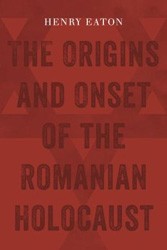By
– September 1, 2011
Between 1940 and 1944, close to half of Romania’s Jewish population was killed by Romanian troops, without necessarily having been urged to do so by Nazi Germany. Whereas Hitler murdered Jews in the name of fighting Bolshevism and imposing a new order in Eastern Europe based on racial supremacy, this was not the objective that prompted mass murder in Romania.
The persecution and murder of Romanian Jewry, argues Vladimir Solonari, stemmed from the effort of the country’s dictator, Ion Antonescu, and his followers to create an ethnically pure Romania. Antonescu believed that foreign elements, especially Jews, controlled all aspects of Romania’s economic and cultural life and sought to replace them with Romanians who could prove their descent from the original Roman colonizers who intermarried with the indigenous population. Thus the combination of xenophobic nationalism, including virulent anti-Semitism; the acquisition of territory that Romania believed historically belonged to them, and the fear of Communism emanating from the Soviet Union led Antonescu to forge an alliance with Hitler, whom he believed would be sympathetic to his policy of purifying the Romanian nation.
Antonescu’s policy entailed the expulsion of the various ethnic groups that resided in the country, which included Hungarians, Bulgarians, Ukrainians, Gypsies, and Jews. One method of attaining this vision of a “Romania for Romanians” was to engage in population exchanges with the various countries that these minorities represented, but in the case of Gypsies and Jews, there was no country to exchange with; hence the decision to deport these latter minorities to the disputed territory of Transnistria. During this process of ethnic cleansing, terrible massacres by Romanian military and police units were perpetrated against both the Jews and Gypsies, with perhaps the worst of these mass murders during the Iasi pogrom in June 1941, which witnessed, according to Solonari, the murder of between 8,000 to 15,000 Jews. The massacre coincided with Nazi Germany’s invasion of the Soviet Union wherein Romanian army units joined the Wehrmacht in the war against Bolshevism.
Romania was an ally of Nazi Germany as long as Antonescu believed that Hitler would be successful in winning the war. But by the beginning of 1942, the war had turned against Germany, and Antonescu feared the consequences of being on the losing side. Solonari contends that this was an important consideration in explaining why Antonescu refused to deport Bucharest’s Jews to Belzec despite the Nazi pressure to include Romania’s Jews in the planned Final Solution.
The non-specialist may find Solonari’s book a bit difficult due to lack of familiarity with the names of the many Romanian perpetrators involved in Romania’s role in the Holocaust, but the book i s well worth the effort.
The persecution and murder of Romanian Jewry, argues Vladimir Solonari, stemmed from the effort of the country’s dictator, Ion Antonescu, and his followers to create an ethnically pure Romania. Antonescu believed that foreign elements, especially Jews, controlled all aspects of Romania’s economic and cultural life and sought to replace them with Romanians who could prove their descent from the original Roman colonizers who intermarried with the indigenous population. Thus the combination of xenophobic nationalism, including virulent anti-Semitism; the acquisition of territory that Romania believed historically belonged to them, and the fear of Communism emanating from the Soviet Union led Antonescu to forge an alliance with Hitler, whom he believed would be sympathetic to his policy of purifying the Romanian nation.
Antonescu’s policy entailed the expulsion of the various ethnic groups that resided in the country, which included Hungarians, Bulgarians, Ukrainians, Gypsies, and Jews. One method of attaining this vision of a “Romania for Romanians” was to engage in population exchanges with the various countries that these minorities represented, but in the case of Gypsies and Jews, there was no country to exchange with; hence the decision to deport these latter minorities to the disputed territory of Transnistria. During this process of ethnic cleansing, terrible massacres by Romanian military and police units were perpetrated against both the Jews and Gypsies, with perhaps the worst of these mass murders during the Iasi pogrom in June 1941, which witnessed, according to Solonari, the murder of between 8,000 to 15,000 Jews. The massacre coincided with Nazi Germany’s invasion of the Soviet Union wherein Romanian army units joined the Wehrmacht in the war against Bolshevism.
Romania was an ally of Nazi Germany as long as Antonescu believed that Hitler would be successful in winning the war. But by the beginning of 1942, the war had turned against Germany, and Antonescu feared the consequences of being on the losing side. Solonari contends that this was an important consideration in explaining why Antonescu refused to deport Bucharest’s Jews to Belzec despite the Nazi pressure to include Romania’s Jews in the planned Final Solution.
The non-specialist may find Solonari’s book a bit difficult due to lack of familiarity with the names of the many Romanian perpetrators involved in Romania’s role in the Holocaust, but the book i s well worth the effort.
Abraham J. Edelheit is an associate professor of history at Kingsborough Community College (CUNY) and the author, co-author, or editor of eleven books on the Holocaust, Zionism, Jewish and European history, and Military affairs. His most recent publication appeared in Armor magazine, the official journal of the US Army Armor and Cavalry Command.





